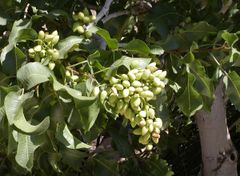
Scientific Name of Plant[]
- Pistacia vera
About Pistachio nut[]
Wikipedia Article About Pistachio nut on Wikipedia
The Pistachio (Pistacia vera, Anacardiaceae; sometimes placed in Pistaciaceae) is a small tree up to 10 m tall, native to southwestern Asia (Iran west to the Levant). It has deciduous pinnate leaves 10-20 cm long.
The plants are dioecious, with separate male and female trees. The flowers are apetalous and unisexual, and borne in panicles. The fruit is a drupe, containing an elongated seed (a nut in the culinary sense, but not a true botanical nut) with a hard, whitish shell and a striking light green kernel, having a very characteristic flavour.
When the fruit ripens, the shells split open partially (see photo). This happens with an audible pop, and legend has it that lovers who stand under a pistachio tree at night and hear the nuts popping open will have good luck.
Cultivated in California, Italy, Turkey and Iran, the pistachio has a hard, tan shell that encloses a pale green nut. The shells of some pistachios are colored red (with vegetable dye), while others have been blanched until white. The California Pistachio Commission states that these nuts are dyed for two reasons: because many people find that form familiar; and so they're easier to spot in a bowl of mixed nuts. Pistachios are available year-round shelled and unshelled, either raw or roasted and salted or not. When buying unshelled pistachios make sure the shells are partially open-not only because it's a great help in getting the nutmeat out, but because closed shells mean the nutmeat is immature. Pistachio nuts have a delicate, subtle flavor that is wonderful either for eating out of hand or for flavoring both sweet and savory dishes. Pistachio nuts are rich in calcium, thiamine, phosphorus, iron and Vitamin A.
